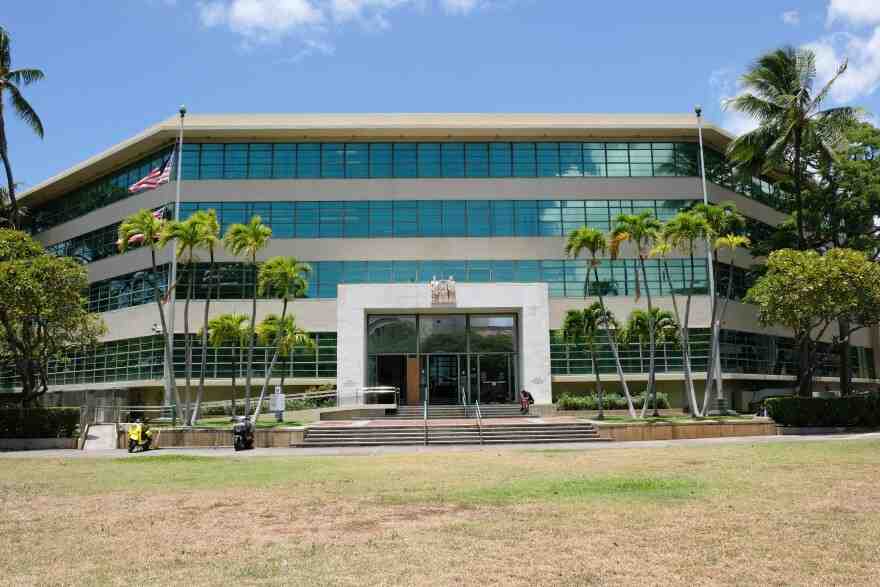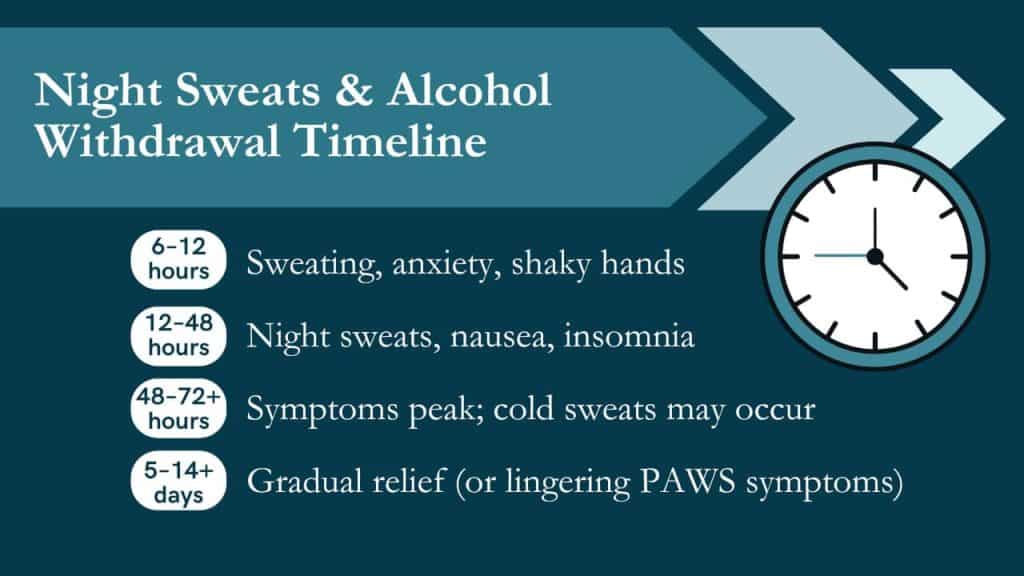
Why Understanding the Alcohol Withdrawal Timeline Matters
The alcohol withdrawal timeline is a critical roadmap for anyone stopping heavy, prolonged drinking. Knowing what to expect—and when—can be the difference between a safe recovery and a medical emergency.
Quick Answer: The Alcohol Withdrawal Timeline
- 6-12 hours: Mild symptoms begin (headache, anxiety, tremors).
- 12-48 hours: Symptoms intensify; hallucinations and seizures are possible.
- 48-72 hours: Peak severity; highest risk for delirium tremens (DTs).
- 3-7 days: Physical symptoms gradually subside.
- Weeks to months: Psychological symptoms may linger (PAWS).
Alcohol withdrawal occurs when a person who drinks heavily suddenly stops or cuts back. Their brain and body have adapted to the constant presence of alcohol, and its absence sends the nervous system into overdrive. This process is not just uncomfortable; it can be life-threatening without medical care.
However, with medical supervision, you can steer this storm safely. Thousands of people successfully complete alcohol withdrawal each year and begin lasting recovery.
At Addiction Helpline America, we guide individuals through the alcohol withdrawal timeline with compassionate, evidence-based support. We understand every withdrawal is unique and are here to connect you with medical resources and treatment programs to keep you safe during this critical first step.
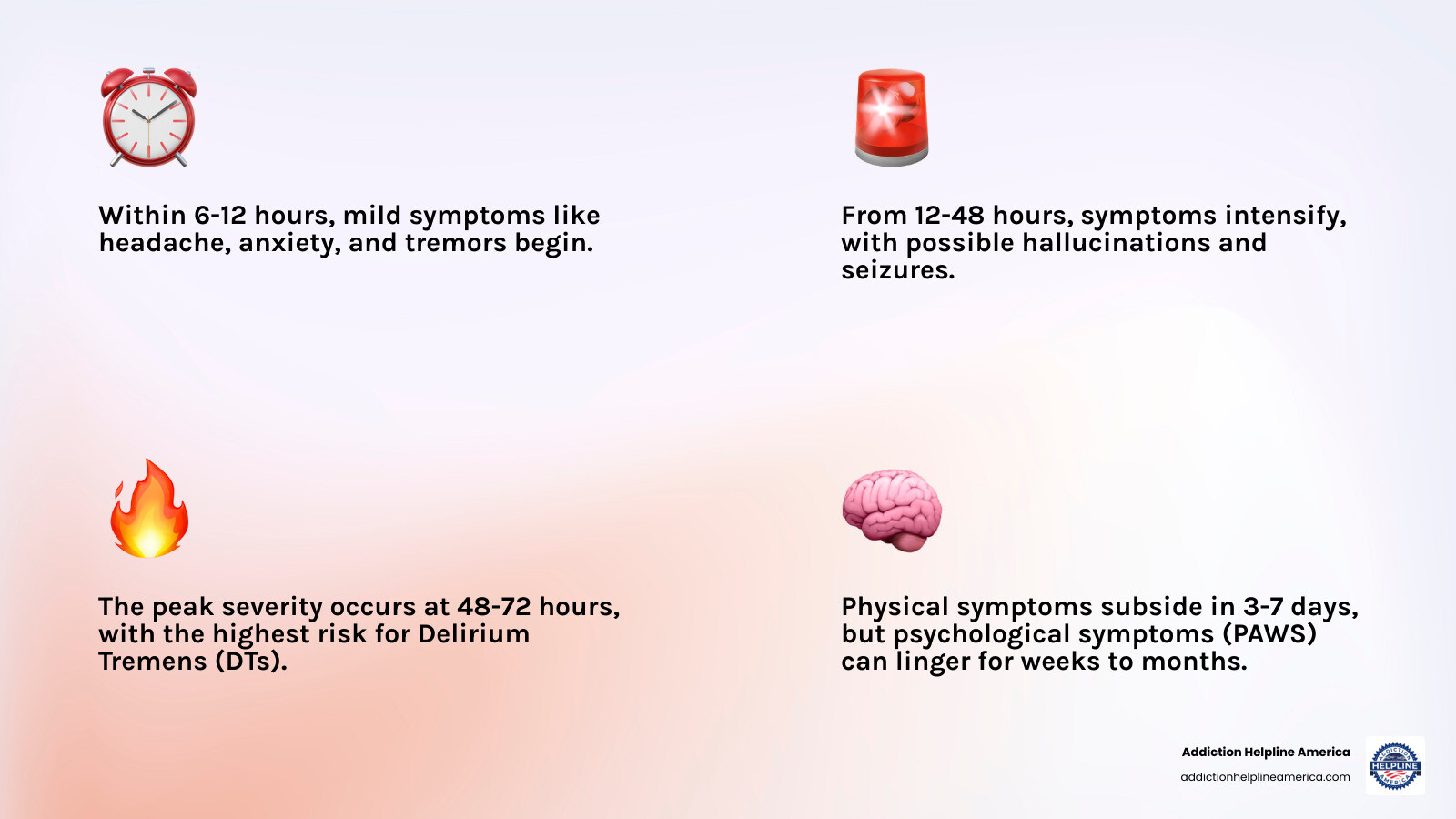
Understanding Alcohol Withdrawal Syndrome (AWS)
When someone with alcohol dependence suddenly stops drinking, they experience Alcohol Withdrawal Syndrome (AWS), a serious condition that is far more than a bad hangover.
Alcohol is a central nervous system depressant. It slows brain function by boosting the calming neurotransmitter GABA while suppressing the excitatory neurotransmitter glutamate. With chronic heavy drinking, the brain adapts to this constant suppression. It starts producing less GABA and more glutamate to function “normally” with alcohol in the system.
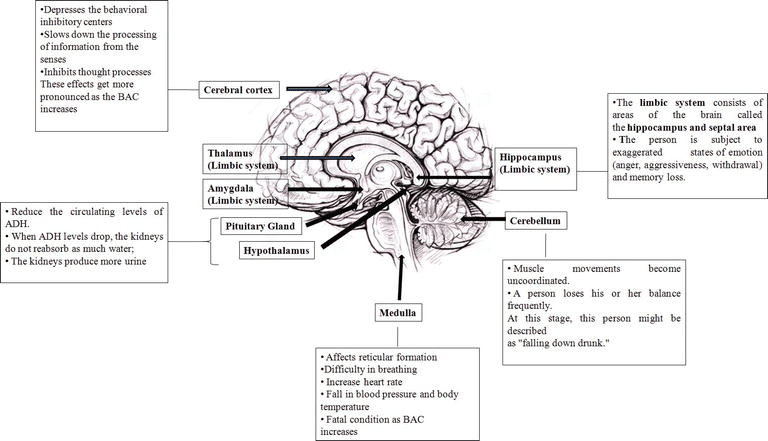
When you suddenly stop drinking, this adapted brain is left with too much glutamate and not enough GABA. Your nervous system goes into a state of hyperactivity. This rebound effect is what causes withdrawal symptoms—it’s like the brain’s accelerator is stuck to the floor with no brakes. This neurochemical chaos is why medical supervision during the alcohol withdrawal timeline is so important. You can explore more about this process through scientific research on alcohol’s effect on the brain.
Common Symptoms of AWS
AWS symptoms vary from uncomfortable to life-threatening. Recognizing them early is key to getting help. Common symptoms include:
- Psychological: Anxiety, irritability, mood swings, and confusion.
- Physical: Headaches, hand tremors (the “shakes”), sweating, fatigue, nausea, and vomiting.
- Sleep-related: Insomnia and vivid or disturbing nightmares.
- Cardiovascular: Increased heart rate (tachycardia), high blood pressure (hypertension), and heart palpitations.
These symptoms are your body’s distress signals. Their severity depends on factors like how much and how long you’ve been drinking and your overall health. This variability is why a medically supervised detox is the safest approach.
The Alcohol Withdrawal Timeline: A Stage-by-Stage Breakdown
When you stop drinking after developing a physical dependence, your body begins a predictable but highly personal journey. The alcohol withdrawal timeline generally follows a pattern, but your experience will be unique.
Symptoms typically begin within 6-8 hours of the last drink, peak in intensity between 24 and 72 hours, and last for an average of five days. The physical symptoms usually improve within a week, though they can persist longer. Understanding these stages helps you know what to expect and when to seek immediate medical help.
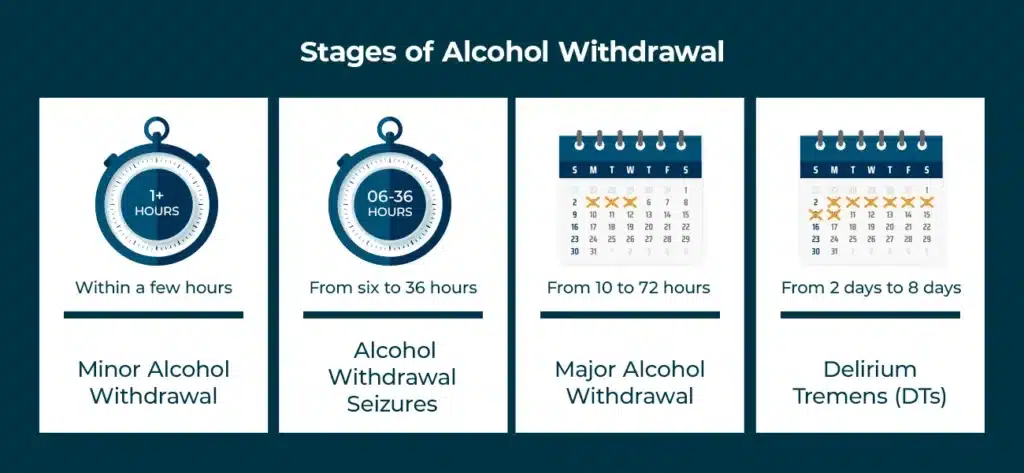
Stage 1: The First 6-12 Hours
The alcohol withdrawal timeline begins quickly. As alcohol leaves your system, you may experience mild symptoms as early as six hours after your last drink. These include a persistent headache, mild anxiety, insomnia, and an upset stomach. Heart palpitations and hand tremors (the “shakes”) are also common. While easily mistaken for a bad hangover, these are the first signs your body is reacting to the absence of alcohol and that you should have medical support in place. You can learn more about these early warning signs from the National Library of Medicine.
Stage 2: The Detailed Alcohol Withdrawal Timeline (12-48 Hours)
Between 12 and 48 hours, symptoms from Stage 1 intensify. This stage also introduces more concerning symptoms as your brain’s hyperactivity increases.
Hallucinations may begin, which can be auditory (hearing sounds), visual (seeing shadows), or tactile (feeling things on your skin). The most critical concern is the risk of withdrawal seizures, which typically occur between 24 and 48 hours. These are often generalized tonic-clonic seizures and are a primary reason why medical supervision is essential. Confusion and disorientation also frequently set in during this phase.
Stage 3: The Peak (48-72 Hours)
This is the most dangerous part of the alcohol withdrawal timeline. Between 48 and 72 hours, symptoms reach their peak, and the risk of life-threatening complications is highest.
The most serious risk is Delirium Tremens (DTs), a severe form of withdrawal requiring immediate medical attention. Symptoms of DTs include profound confusion, severe agitation, high fever, and frightening hallucinations. Your heart rate and blood pressure can spike to dangerous levels, and seizures may continue. This 48 to 72-hour window is when life-threatening symptoms are most likely to appear, making it critical to be under medical care. For more information on severe complications, the National Library of Medicine offers comprehensive resources.
Stage 4: Post-Acute Alcohol Withdrawal Timeline (PAWS)
After the first week, the acute physical crisis typically passes. However, the alcohol withdrawal timeline often continues with Post-Acute Withdrawal Syndrome (PAWS). The intense physical symptoms resolve, but lingering psychological symptoms can persist for weeks or months.
During PAWS, you may experience mood swings, low energy, disrupted sleep patterns, and intense cravings. This extended phase, also known as protracted withdrawal, is a normal part of recovery. Your brain needs time to heal and recalibrate its chemistry after prolonged alcohol use. Understanding that PAWS is expected can help you remain patient with yourself during recovery.
The Dangers of Unmanaged Withdrawal
Unlike withdrawal from most other substances, stopping alcohol “cold turkey” can be fatal. When your body has become dependent, suddenly removing alcohol can send your nervous system into a crisis. Attempting to detox on your own is a dangerous gamble.

Without medical supervision, you risk severe complications:
- Withdrawal Seizures: These full-body convulsions can strike without warning, typically in the first 48 hours, and can lead to serious injury.
- Delirium Tremens (DTs): A severe neurological state with profound confusion, hallucinations, and dangerously unstable vital signs (heart rate, blood pressure).
- Cardiac Complications: The strain on your body can trigger irregular heartbeats, heart attacks, or strokes.
- Severe Dehydration: Vomiting and sweating can lead to a dangerous imbalance of fluids and electrolytes, affecting heart rhythm.
- Aspiration Pneumonia: Inhaling vomit during a seizure or while disoriented can cause a life-threatening lung infection.
Developing a withdrawal seizure increases the risk of death fourfold, a statistic that underscores why professional medical help is not optional.
Delirium Tremens (DTs) and Seizures
Delirium Tremens is the worst-case scenario of withdrawal, affecting 3-5% of individuals, typically 48-72 hours after the last drink. It involves severe confusion, agitation, vivid hallucinations, and dangerously high heart rate, blood pressure, and fever. Even with modern medical care, DTs are fatal in 1% to 4% of cases. Seizures add another layer of danger, as they are unpredictable and can cause significant harm if you are not in a safe, monitored environment.
Factors Influencing Severity and Duration
Your personal alcohol withdrawal timeline is influenced by many factors:
- Drinking History: The longer and more heavily you’ve been drinking, the more severe withdrawal is likely to be.
- Previous Withdrawals: Each withdrawal episode can be worse than the last, a phenomenon known as “kindling.”
- Age and Health: Older individuals and those with co-occurring medical conditions (like liver or heart disease) are at higher risk for complications.
- Co-occurring Conditions: Malnutrition, dehydration, and mental health disorders like anxiety or depression can intensify withdrawal symptoms.
- Genetics and Other Substance Use: Your genetic makeup and use of other drugs (like benzodiazepines) also play a significant role.
Given these variables, it’s impossible to predict your withdrawal severity without a medical assessment, making professional supervision essential.
Seeking Professional Help: Medical Detox and Treatment
Attempting to manage alcohol withdrawal on your own is not just difficult; it’s dangerous. If you are physically dependent on alcohol, you should contact a medical professional before you stop drinking. Do not wait for symptoms to appear.
If you or someone else experiences seizures, high fever, severe confusion, hallucinations, or an irregular heartbeat, call 911 immediately. These are signs of a medical emergency. The most effective way to prevent dangerous complications during the alcohol withdrawal timeline is to get professional help early.
A medically supervised detox transforms a potentially deadly ordeal into a safe, manageable process. Professionals can monitor your vital signs, provide medication to ease discomfort, and intervene if complications arise.
The Role of Medical Detox
Medical detox is a structured program designed to guide you safely through the physical withdrawal process. It is the first step in treatment. The goals are to manage symptoms, prevent life-threatening complications, and make withdrawal as safe and comfortable as possible. In a detox facility, you receive 24/7 monitoring and care during the most critical first days. While detox addresses the physical dependence, it is not a complete treatment for addiction. It must be followed by therapy, counseling, and ongoing support, such as that found in inpatient rehab programs.
Medical Treatments for AWS
The cornerstone of AWS treatment is a class of medications called benzodiazepines (e.g., lorazepam, diazepam). These are the “gold standard” because they mimic alcohol’s calming effect on the brain, helping to reduce anxiety, prevent seizures, and manage the dangerous hyperactivity of the nervous system. They are proven to significantly reduce the risk of seizures and delirium tremens.
Treatment also includes crucial nutritional support, especially with thiamine (Vitamin B1) to prevent serious neurological damage. IV fluids are often used to correct dehydration and electrolyte imbalances. Depending on your needs, doctors may also use other supportive medications like anticonvulsants or beta-blockers. This comprehensive medical approach, detailed by sources like the American Academy of Family Physicians, ensures your detox is managed safely.
At Addiction Helpline America, we provide free, confidential guidance to connect you with the right medical detox and treatment centers. Recovery is possible, and it starts with a safe detox.
Life After Alcohol: The Long-Term Benefits of Quitting
Getting through the alcohol withdrawal timeline is the first step toward reclaiming your life. The benefits of sobriety build over time, changing your health and happiness.

Here are some of the remarkable changes you can expect:
Improved Sleep Quality: Without alcohol disrupting your sleep cycle, you’ll experience deeper, more restorative rest and wake up feeling genuinely refreshed.
Better Health and Energy: Sobriety allows your body to properly hydrate, which improves skin health, reduces fatigue, and can lead to natural weight loss as you cut out empty calories.
Financial Savings: Heavy drinking is expensive. Quitting can save you hundreds or even thousands of dollars each month, freeing up money for hobbies, goals, or financial security.
Reduced Disease Risk: You significantly lower your risk for several types of cancer and give your liver a chance to heal from inflammation and damage.
Improved Mental Clarity: The mental fog of heavy drinking lifts, leading to sharper thinking, better memory, and improved focus.
Repaired Relationships: Sobriety allows you to rebuild trust and be fully present with loved ones, fostering authentic and meaningful connections.
Better Emotional Health: While alcohol can seem to relieve stress, it often worsens anxiety and depression over time. Quitting helps stabilize your mood and allows you to develop healthier coping skills.
By addressing alcohol dependence, you are giving yourself the gift of a longer, healthier, and more fulfilling life. At Addiction Helpline America, we’ve seen these changes and are here to help you start your journey.
Frequently Asked Questions about Alcohol Withdrawal
If you have questions about the alcohol withdrawal timeline, you’re not alone. Here are answers to some of the most common concerns.
How long do alcohol withdrawal symptoms last?
While every person’s experience is unique, a general pattern exists. Acute physical symptoms typically begin within 6-12 hours, peak around 24-72 hours, and largely resolve within 3-7 days. However, psychological symptoms, known as Post-Acute Withdrawal Syndrome (PAWS), can linger for weeks or months. These may include mood swings, low energy, and sleep disturbances as your brain continues to heal.
Can alcohol withdrawal be prevented?
If you are already physically dependent on alcohol, some form of withdrawal is unavoidable when you stop. However, the most severe and dangerous complications of withdrawal, like seizures and delirium tremens, can absolutely be prevented with professional medical detox. The only true way to prevent withdrawal is to address problem drinking before physical dependence develops.
How does alcohol withdrawal differ from other substance withdrawals?
This is a critical distinction. Withdrawal from alcohol and benzodiazepines is unique because it can be fatal. The risk of life-threatening seizures and delirium tremens (DTs) requires medical supervision. In contrast, withdrawal from opioids, while uncomfortable with symptoms like muscle aches and nausea, is rarely life-threatening on its own. Withdrawal from stimulants like cocaine or from cannabis is also generally not medically dangerous. This is why you should never attempt to detox from alcohol alone.
Conclusion
You’ve learned about the alcohol withdrawal timeline: symptoms begin within hours, peak around 48-72 hours, and then gradually subside. While the journey is challenging and can be dangerous, it is absolutely possible to steer it safely with the right support.
Hundreds of thousands of people successfully complete medical detox every year and emerge into a new life. Recovery is a long-term process, but it brings rewards like better health, clearer thinking, and healed relationships. Detox is just the first step, followed by ongoing treatment and support that helps you build a meaningful life in sobriety.
If you are worried about withdrawal, that fear is valid. It’s why professional help is essential. Medical detox programs provide the monitoring and medication to keep you safe and comfortable during the most critical phases.
At Addiction Helpline America, we understand your situation is unique. We provide free, confidential, and personalized guidance to connect you with a treatment program that matches your specific needs. Our network includes centers across all 50 states and the District of Columbia, ensuring we can find help for you, wherever you are.
Your story doesn’t end with alcohol dependence. It begins again with the decision to seek help. The healthier, more present, and more alive version of you is waiting on the other side of withdrawal.
Find personalized help with our inpatient rehab programs and start your journey today. You deserve recovery, hope, and the support to get there safely.
Our helpline is 100%
free & confidential
If you or someone you care about is struggling with drug or alcohol addiction, we can help you explore your recovery options. Don’t face this challenge alone—seek support from us.
Programs
Resources
Will my insurance
cover addiction
treatment?
We're ready to help
Find the best
drug or alcohol treatment
center
Are you or a loved one struggling with addiction? Call today to speak to a treatment expert.









